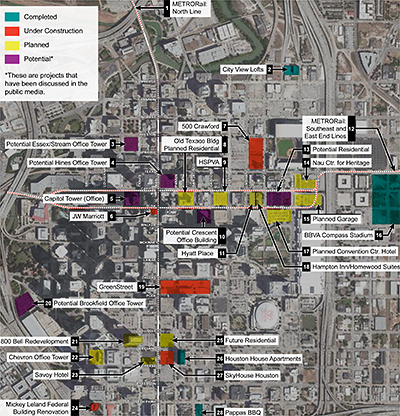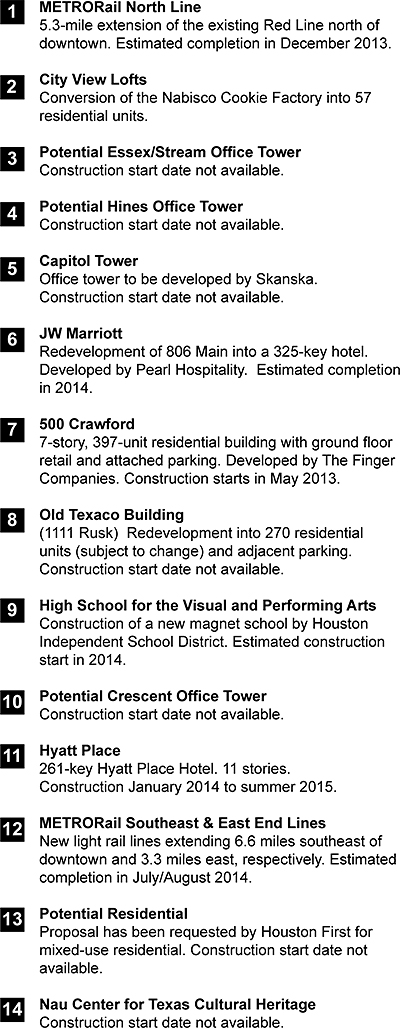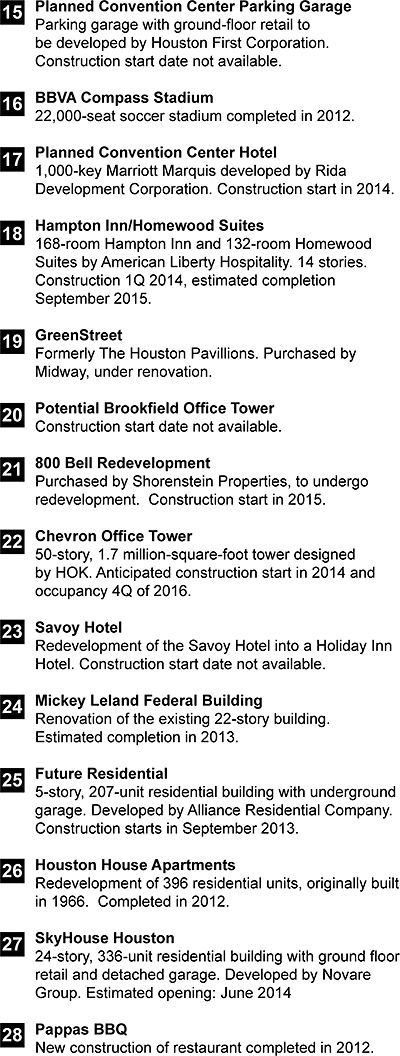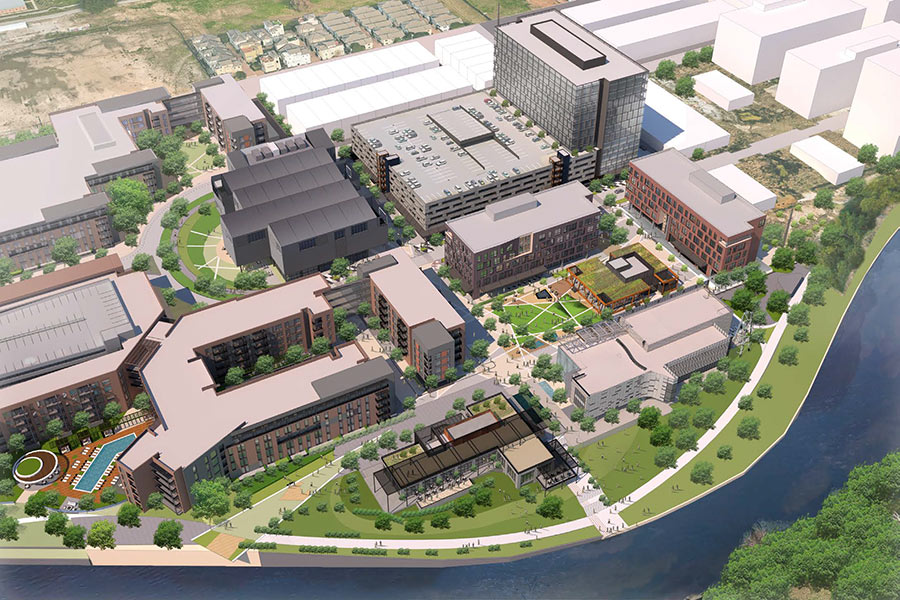
Last week’s announcement by Chevron of the 50-story tower it plans to add to its blue-glass twins is just the latest development in the 77002. This map from the Downtown Management District shows projects that are recently completed, under construction, or in various states of planning and speculation. Those projects, denoted by purple and yellow on the map, include Skanska’s 34-story office tower that’s replacing the old Houston Club Building, Hines’s highrise on Main, the residential renovation of the Texaco Building, and the 5-story apartment complex near the under-construction SkyHouse apartment tower, among others. You can scroll through a complete legend for the map after the jump:
***


- Development [Downtown Houston]
- Previously on Swamplot: Chevron’s New 50-Story Tower on Site of Downtown Y: Bigger, Boxier, Just as Blue, No, the Renovated Bell St. ExxonMobil Building Is Not Gonna Look Like This, Hines Interested in Building Residential Tower on Downtown Block Near Market Square Park, From No Such Heights: Downtown’s Next Apartment Building To Rise Just 5 Stories, Hilcorp Shows Employees the 20-Story Tower Replacing the Downtown Macy’s, The Old Savoy Downtown To Become New Holiday Inn, Skanska’s New Downtown Office Tower, Could This Be Downtown’s Next Residential Highrise?, GreenStreet, Frame by Frame: Previewing the Upcoming Houston Pavilions Remake, Does New Hines Highrise Mean Old Texas Tower’s a Goner?, Where Downtown’s New Residential Tower Will Go
Images: Downtown District





Over 1000 new residental units downtown. That has to be a significant % addition to the current residential units. Plus Eado’s gains in residents. Plus 2000+ hotel rooms. It’s becoming almost a neighborhood which could eventually beget some interesting non-chain retail and character other than a Brutalist work environment.
The downtown development pattern looks to be following the N/S & E/W rail axes.
I’ve got a chicken and egg question:
Does all this go downtown without rail?
Is the explosion of GRB conv. area growth more do to Discovery Green or b/c the rail will connect it to the rest of downtown?
Does the downtown boom eventually give us a credible example of rail spurring development, increasing the tax base, and therefore is worth the cost?
surprised I am the first comment here…
Has anyone noticed that Houston’s skyscrapers are pretty flat topped? It is a little over-done. I want to see: a) Taller buildings (Over 50 stories) and b) some architectual interest at the tops. Is that too much to ask for? For a city that will be the 3rd largest in the next decade, we need to step up our game.http://skyscraperpage.com/diagrams/?cityID=28
Andoni, totally agree. What’s up with so many super-boring tall rectangles in our skyline??
Does Houston keep usig teh same architects or do they not look at all the amazing design going up in world-class cities, like Dubai, Tokyo and NYC, among others??
Houston downtown buildings have a lot of flair, some of the new ones being added might not, but even if the ratio is 1 to 10 of interesting buildings to meh buildings, it’s enough and probably the same as other cities have.
Most importantly though is looking at how things seem to be following the tracks of the rail…
I think the lack of architectural boldness has to do with lack of flamboyant rich developers who are willing to throw more money around than required in a project for posterity sake. Are they gone because the economy tanked recently? Are they gone because the popular sentiment in the US has rich people and success in general demonized? Or are the design decisions made by way too many people who have to reach consensus thereby resulting in the design of “least common denominator”?
—
Dubai and that area in general is staring in the face of the biggest real estate bubble crash in the world, in some areas real estate is 80% owned by speculators with no possibility of having enough “end-users” to fill the vacancies.
There it is again, that term ‘world class’ city. What does it mean?
From what I understand, the light rail is considered by most property owners and developers in downtown as either neutral or a minor amenity, especially for office and residential. Discovery Green (and perhaps the renovated Market Square?) has meant much more as a spur for development. Regarding transit, Park and Ride service to the outer suburbs is way more important than light rail for the office market. Perhaps the sector of downtown land use that finds light rail most meaningful is lodging, so hotel guests can more easily get to the museums and Hermann Park.
The focus shouldn’t be how to make the skyline look good but how the make the street level experience great. Doesn’t do anyone any good if it looks awesome 2 miles out but is dismal once they get there. People will invest in an area that has a vibrant active street life based off the pedestrian experience not off a postcard.
Nothing about Macy’s / Hillcorp? That must be a super-secret project…
There’s also the potential Hines residential tower on the Prairie, Preston, Travis, Main block. Or did I miss news otherwise?
Light rail has not to date really spurred development around it’s stations because it is not a speedier transit option for people along it’s route. I’m pretty sure you can drive from Main and Bell to Binz just as fast as it would take on LRT, because the trains ride in the street and also stop for cross traffic in some spots. Also, traffic congestion along Main St., or the East End is nowhere near a critical mass that driving becomes something you want to avoid.
.
Dallas’ DART rail used railway right of ways that took the trains off the street grid, and is able to provide speedy transit down the North Central Expressway corridor. Real estate development followed around the station nodes because people are willing to eat/shop/live close to a station that lets them avoid a terribly congested highway at rush hour.
.
METRO did own old railroad ROW’s along Westpark and the Katy Freeway, but never had anyone in charge that was willing to develop those ROW’s for rail use. They became concrete highways instead.
bingo! matthew wins. couldn’t have said i better myself.
The concern over the street-level experience is why the downtown residential incentive programs include urban design requirements for the ground level – to avoid long blank walls and parking structures as your sidewalk-fronting uses.
I agree that street level experience is vital to improving Houston’s downtown experience. I was looking at the website i posted earlier on this thread… and I noticed construction boomed in Houston from the mid 70’s to the mid 80’s. Definitely a few things before and after that are noteworthy too. I think we are starting to see a trend of large office buildings being built now. Late 2000’s to ?? Who knows. But I think now is the time to get it right. We have only a select amount of opportunities to build something that is going to impact Houston as much as a skyscraper. I hope to see more innovative, interesting, and functional buildings. Something over the standard 40-50 stories would be nice. Something with enough funding to be original and impactful without being wasteful. I think we have potential guys. But right now we simply cannot make the argument our city is any better than Chicago, NY, or LA when they are planning 120 story buildings and we muster the usual 50 story flat top.
When you’re building an office highrise, you’re essentially multiplying the value of the land you own times the amount of floors. The value of land in Houston is simply not high enough to justify building more than 50 stories or so, and the higher you go, the higher the costs. Remember, to add a floor to a building you essentially have to add 1 floor at the bottom to support all the weight of floors above which starts getting exponentially more expensive. The current office rental rates in Houston prohibit buildings as high as in New York for example.
Extra-tall buildings also lose leaseable area due to increased elevator space, though that is partially compensated for with sky-lobbies and changeover points.
It also takes a lot of energy to pump water way up there, plus handle other systems. To do this kind of project, you have to be confident that tenants will be willing to pay to cover the higher operating costs as well as your capital recovery / financing costs from development. You’re basically depending on view premiums on your lease rates.
Whether the building is above or below 50 stories doesn’t mean great design. A rectangle glass box is a rectangle glass box regardless of height. When design only has a utilitarian purpose, you get a utilitarian design. We are becoming living proof that you don’t need to be a old style communist country to have boring buildings….just have the buildings built by bottom line capitalists and you get the same thing. Not saying that is bad or good, but when the only motivation is to save money you aren’t going to get great architecture. In the 80’s a lot of the really great skyscrapers in Houston were built by local banks trying to outdo each other. We are no longer dominated by “locals” and international business has nothing to prove like the locals did. We have no egos left that are driving great architecture, and have apparently reduced our local boosterism to marketing terms and becoming “world class” (whatever that is!). Oh well…..
@Dana-X: I’m counting 1,606 residential units just from the projects far enough into planning to list numbers. That doesn’t include the potential Hines residential tower by Market Square Park or the residential Houston First RFP’d by the convention center. Those should easily bump us over 2000 new units.
So I completely agree – that much fresh blood should create local character.
All is not lost. Five Houston Center has one of those curvy roofs that everyone loves (or hates). Finger’s apartments at Discovery Green have a neo-neo-neo Gothic Revival roofline. And the new Hess building has a non-functional wind turbine for a roof. Maybe people do not put a lot of design into the roof line when they anticipate that the building will be enveloped by other skyscrapers?
Light rail has exactly zero causal relationship to any of this development.
Light rail is doing exactly what it is supposed to be doing, the issue with Houston transit is the lack of park&ride buses and regular buses across the region connecting to light rail and employment centers.
As the adjacent areas around the light rail densify and add attractions it will become useful, especially for visitors. Just think, we will soon have 5 major sport venues (Astros, Rockets, Texans, Dynamo, and UH) all connected to rail. That’s a major plus for hosting major events.
For sprawl cities, the cost of oil might be the main driver of future development – ironic more so for Houston. In the coming decades when oil/gas prices double/triple, I suspect that’ll both decrease regional traffic while increase high-density residential (eg., Vancouver BC) & commercial (eg., Chicago in the loop) development in the city center. It’ll be a memorable day for the city if/when rail transit finally starts connecting the suburbs and the airports to line hubs in the city.
ShadyHeightster, this Houston self-loathing gets so tiresome. To the extent there has been more TOD along DART (and it’s really quite minimal), it’s largely because Dallas and its suburbs have happily subsidized it. We don’t do so much of that in Houston. In spite of DART running in its much-glorified abandoned rail lines, it still takes it 36 minutes to get from downtown Dallas to downtown Plano. Because of DART’s long headways,the average wait for a train will be 10 minutes, meaning the trip will be an average 46 minutes, station to station. Most drivers will beat that transit time with ease.